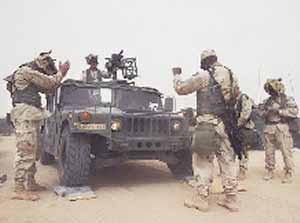| The session took on added importance,
coming before the deadline Bush imposed on Saddam. The Iraqi leader can
avoid war if he flees his country by 8 p.m. EST Wednesday, the president
said.
War won't necessarily begin at the deadline.
Aides said Bush would decide on the timing of military action based on
the advice of military leaders.
In Kuwait, one battalion chaplain led troops
in a Seminole war dance, and the company commander told the men to remove
the American flags that fluttered from the tops of the tanks because "we
will be entering Iraq as an army of liberation, not domination."
The soldiers had slept under the stars
after packing their tents into the back of their convoy, where they will
likely stay until the worst of the fighting is over.
The 3rd Infantry Division is the only armored
force in the region and is likely to attack Iraqi defenses head-on in the
event of war. Troops of the 101st are expected to be flown in on helicopters
to seize key installations ahead of the 3rd Division.
At the Army's Camp New Jersey, the commander
of the 101st Airborne Division' 3rd Brigade summoned his officers for a
"battle update" briefing. "We are one day closer to making history, everybody,"
said Col. Michael Linnington.
A strong sandstorm swept in Wednesday,
affecting several units and hampering movement and visibility. The winds
later died down, but a lot of haze remained, with visibility a little over
a mile.
Maj. Gen. David Petraeus, commanding general
of the 101st Airborne Division, said, "We always watch the weather because
it has an effect on flying conditions and really a lot of the activities
you can see. Everything takes a little bit longer."
"It'll slow things down somewhat, but our
soldiers will get everything done in the end," Petraeus said.
About 300,000 troops - most of them from
the United States, about 40,000 from Britain - waited within striking distance
of Iraq. Backing them were scores of attack helicopters and more than 1,000
airplanes.
At sea, the aircraft carriers USS Theodore
Roosevelt and Harry S. Truman moved a step closer to war footing, getting
ready to conduct operation flights around the clock.
On the USS Theodore Roosevelt, combat pilots
and others were ordered to snooze through the day Wednesday so they could
work through the night. Those on the USS Harry S. Truman remained on day
duty - thus providing round-the-clock combat capability.
Near the war zone, commander Tommy Franks
hunkered down with other top military officers at the forward command center
in Qatar, about 700 miles from Baghdad.
"He wants to make sure that the commanders
have thought about every possible contingency that you can," said U.S.
Central Command spokesman Jim Wilkinson said of Franks.
"But he also is realistic enough, and has
been around enough, to know that every military plan changes once the first
bullet's fired."
Equipment, supplies and troops continued
to arrive in Kuwait, where most of the U.S. and British ground troops preparing
to invade Iraq were awaiting their final orders. Military officials said
there was no last-minute surge in activity at Kuwait's ports and airfields
because front-line units were already prepared.
In the desert near the border with Iraq,
U.S. troops packed up their gear and loaded it onto cargo trucks and armored
vehicles. Soldiers said they were a bit apprehensive but ready to move
into Iraq.
"I'm kind of excited, wanting to see if
we go north. The faster we do, the faster we go home," said Spc. Servando
Diaz of San Jose, Calif.
After driving in a convoy for several hours,
members of the 3rd Infantry Division's A Company, 3rd Battalion, 7th Infantry
Regiment took up a defensive position along with two tank companies. Climbing
down from the turrets, the men's faces were crusted with dirt from the
sandstorm and the sand kicked up by the Bradley fighting vehicles and Abrams
tanks.
"We've got a lot farther to go," said Capt.
Chris Carter of Watkinsville, Ga. With infantrymen surrounding his headquarters
vehicles on one side, and tanks on the other, he positioned them into a
windbreak.
Earlier, the commander of A Company, 4th
Battalion, 64th Armor Regiment, which is also part of the 3rd Infantry
Division, rallied his troops before leading them to the Iraqi border.
After a brief prayer, the battalion chaplain,
Capt. Philip Wolford of Marysville, Ohio, led the troops in a Seminole
Indian war dance. After making sure their weapons were empty, the men started
chanting, jumping up and down with their weapons in the air.
The company commander told them to take
down the U.S. flags from the tops of the tanks.
"We will be entering Iraq as an army of
liberation, not domination, so it would not be right to go in with the
American flag flying," Capt. Chris Carter said.
The aircraft carrier USS Kitty Hawk met
with an ammunition ship, the USNS Flint, to load more 1,000-pound Joint
Direct Attack Munition bombs and Phoenix air-to-air missiles. Crews waited
to load the weapons onto the carrier's F/A-18 and F-14 warplanes.
"We might be able to use them quickly,"
said Capt. Thomas A. Parker, the carrier's commander. "We've got some room
down below, so we're going to fill her up with as much as we can hold."
U.S. officials also continued planning
for governing Iraq after Saddam. The man who would be Iraq's civil administrator
after the U.S. takes control, retired Army Lt. Gen. Jay Garner, was in
Kuwait as those preparations continued. .

|
